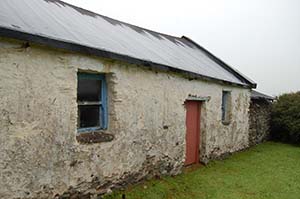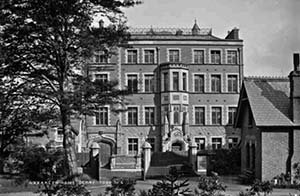Wandering bard, Eoghan Roe Ward, left a touching snapshot of Peig Sayers in her twilight years when he visited her in her home in Vicarstown, Dunquin, in 1944. Peig was, he said, one of the hidden souls of Ireland seldom shown to the stranger and recalled how her voice settled in the depths of his soul, ‘more beautiful than I can describe.’1
Ward was welcomed into Peig’s cabin and sat by the fireside with her and her family where they exchanged stories.

Ward was very much at home in Kerry and especially in Ballyferriter – the ‘Dingle Republic’ – where lived his good friend Sean Kavanagh.2
Ward was then a well-known character in Ireland, his ballads enlivening many a fair and pattern. He wrote an autobiography of his years travelling the roads and though there was great interest in his work, he was unsuccessful in securing publication.3
The fate of the manuscript is not known but the following appears to be taken from it, and relates to his childhood in an orphanage in Derry in the early 1920s.4
Once, during the Derry riots, one of my companions stood on a chair and looked out of a skylight window in a bedroom at the top of the building.5 Then we saw the boy falling from the chair, blood streaming from his head. He had been shot dead by a sniper. His body was swiftly taken away, and we were brought immediately to the chapel to pray for his soul.6 A woman aged about forty, named Fanny Mullen, helped the nuns to look after the boys. She was the most dreaded figure of them all. She had been brought up by the Sisters at one of their orphanages, and, being unable to find work outside, was kept on to assist the nuns. Most of the time she had full authority, and she was never backward in using it. She had favourites, but her enemies were in the majority. She beat the boys terribly, but the nuns took little notice of her actions. Another of the servants was Devlin, the coachman, who drove the Sisters when they had occasion to go out. He was well liked by the boys because he often gave them sweets and other presents, or, as a special treat, a drive in the coach. A frequent visitor was Dr Farren, a professor of St Colum’s College. At that time – about 1921 or 22, I remember him as a middle-sized man with brown bushy hair and thin features. He was very popular with us, for often he brought sweets. But the Sisters, to whom he would give the sweets for distribution amongst us, would usually take them away, so that we never saw them. We dared not complain to the good man for fear of the consequences. The Dean of the College, Dr McGlinchy, a stout man in his early forties, taught us to sing O’Donnell Abu, Wrap the Green Flag Round you, Boys and The Soldiers Song. He wore gold-rimmed spectacles which suited his smiling face.7 The sisters, to my eyes, were all alike though I grew to think that the tall nuns were always good natured and gentle, while the small ones were harsh and forbidding. I remember well one nun, a tall woman named Sister Anthony. She was good to the boys, we all liked her. One particular incident concerning her I shall always remember. It was on a summer’s afternoon in the grounds of the college. During the summer, the children being on holiday, we were allowed into the college ground to play. Some of us who were more daring strayed away from the others, and raided the orchard. Not content with that, we went into the college buildings and stole pencils and stationery. We had not the cunning to hide the stolen property, with the result that Sister Anthony questioned us about it. Being afraid to tell her a lie, we confessed the truth. She told us that punishment was in store for us – a good hiding, nothing less. But instead of the beating, she took each one of us aside separately, and told us a story about stealing and its consequences. She also reminded us how God had died so that we should always be good boys. I was impressed by her kindness, and promised her I would not steal again. But there again came times when I would be ravenously hungry, and I would forget the promises I had made; forget, too, that God had died for the sins of the world. Some kind benefactor arranged for a Christmas party for the children in the orphanage. For weeks beforehand I had been joyfully looking forward to this treat, but when the great day came it was discovered that I had no boots to wear at the party. Fanny Mullen took me to a lavatory at the top of the building, and there I was locked in.

Peig’s neighbours in Vicarstown were the Daly family. In 1898, John Daly, otherwise Seaghán Ua Dálaigh, national school teacher at Dun Chaoin and collector of folklore, recorded a 34-stanza poem about the Blasket Island.
The Island had, since 1892, been the home of his one-time student Peig and her husband Pets ‘Flint’ Ó Guithín.8 The following is a literal translation of the first five verses by Seán Looney, Killarney:
The Island Quilt
I searched high and low a long time,
All-over England, France and in Spain,
It ended abruptly when I landing in Cork,
After hearing the sounds from the boat.
In my wayfaring I couldn’t imagine,
I’d ever see ‘beauty’ so fine,
Just like a magically arranged pearl,
The more recent large quilt of the Island.
It’s such a fine ‘ornament’ to gaze upon,
Whoever studies the story may understand,
Because we are sinners it can’t be explained,
Save by the wisdom of the prophet or a saint.
Difficult making a frame to stretch it,
It has a remarkable vision for life,
That would lead to converting a Turk
And will safely return once again.
It’s because of the quilt’s pattern,
That learned scholars don’t understand,
Every limb and branch in the forest,
Appear from all aspects of it.9
John Daly, whose pseudonym was ‘Common Noun’, was born in 1861, son of Dunquin fisherman, Micil Daly and his wife Mary Muircheartach.10 He was educated in Dun Chaoin and spent a year at St Patrick’s College, Drumcondra. Later he was a monitor at Dun Chaoin school where his uncle, Donall O Muircheartaigh, was master. He took over the school on his uncle’s death.
He married Hanoria, fifth and youngest daughter of Maurice Murphy, Glenfawn, at St Mary’s Church, Dingle on 1 February 1887 and had seven sons and two daughters. His youngest son Joseph (1909-1992), otherwise Joe Daly, Seosamh Ó Dálaigh or Dàlach, was a full time collector for the Irish Folklore Commission. His recollections of Peig Sayers included her annual visit home to Vicarstown at Christmas, when great storytelling gatherings took place.11
Daly contributed to the Gaelic column of the Kerry Sentinel from its inception, his writings ‘eagerly looked forward to by our Gaelic readers.’12 His essays and stories were collected in Clocha Sgail (1930) and Timcheall Chinn Sleibhe (1933).13
John Daly died in February 1940 and was buried in Dun Chaoin graveyard.
__________________
1 Michael O’Donohoe Collection Catalogue (2018), ‘Peig: In search of her Castleisland Roots’, pp707-717. 2 For an account of Eoghan Roe Ward, see the Michael O’Donohoe Collection Catalogue (2018), ‘Peig: In search of her Castleisland Roots’, pp707-717. 3 Fragments of Ward’s writings are held in the National Library of Ireland, MS 31,755. 4 From the scant detail given, the orphanage was probably Nazareth House, located at Bishop Street, Derry, which was located directly across the road from St Columb’s College (Lumen Christi College now occupies the old site; St Columb’s College was relocated to Buncrana Road, Derry). 5 Further reference to this period in The Outrages 1920-1922 (2012) by Pearse Lawlor. 6 The Sisters of Nazareth, Nazareth Regional Office, Malahide Road, Dublin, were approached about the identity of the deceased child but Sister Annette O’Gorman, on behalf of Sister Cornelia Walsh, Regional Leader, was unable to disclose any information in accordance with GDPR. However, the victim would appear to have been 12 year old George Caldwell, ‘who was riddled with gunfire as he sat in his dormitory’, as documented in The Poor Sisters of Nazareth and Derry 1892-1992 (1992) by Very Rev Bernard J Canon Canning, Ch V, ‘Riots of 1920’, p63. My sincere thanks to Kevin Brown, Assistant Archivist, Congregation of the Sisters of Navareth, London, for providing this reference. 7 A photograph of Very Rev James McGlinchey appears on p63 of The Poor Sisters of Nazareth and Derry 1892-1992 (1992) by Very Rev Bernard J Canon Canning. 8 The 34-stanza poem (in old Irish) about the beauty of a Blasket Island quilt is held in the O’Donohoe collection (IE MOD/C17). Daly collected the poem from John Dunlevy. Peig Sayers has an account of her time in class in Peig. 9 The 34-stanza poem (IE MOD/C17) has been translated into English by Seán Looney, Killarney. It is held in IE MOD/C40. Special thanks to Seán Looney for this valuable contribution to the O’Donohoe Collection. 10 His father died in a fire and his mother in childbirth with her third child. 11 A photograph of Joseph Daly appears on p187 of ‘Seosamh Ó Dálaigh’s Memories of Peig Sayers’, Béaloideas, ImI 80 (2012), pp183-192. 12 Kerry Sentinel, 24 June 1899. 13 A review of Clocha Sgail (Kerry Diamonds) was published in Irish in the Kerryman, 5 April 1930, p9. It described the book as Daly’s first publication, though he had contributed articles and essays to An Claidheamh Soluis and other newspapers for many years. The book contained stories and accounts of people and animals from the people of Dunquin in words and phrases never before seen in print which included stories about seals and sea-birds and other creatures from those which daily ‘ploughed the waves’. The title of the book is the name given to amethysts found in Corkaguiny and elsewhere in Kerry and commonly called ‘Kerry Diamonds.’ My thanks to Seán Looney, Killarney, for this summary of the above quoted review.


